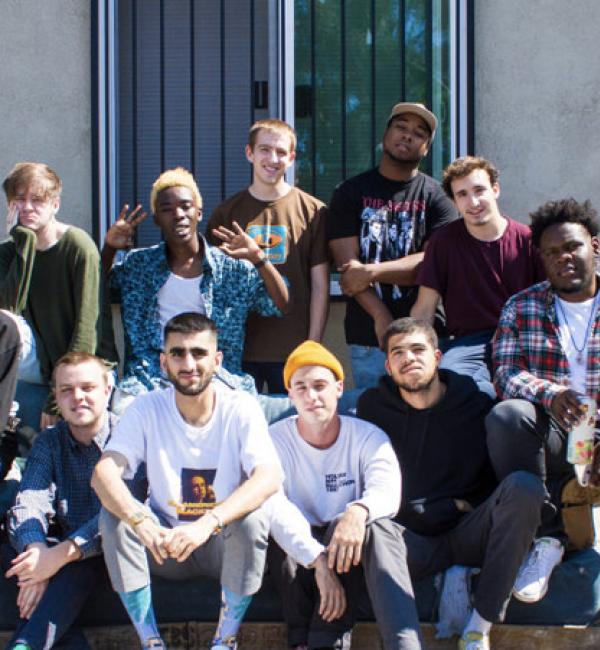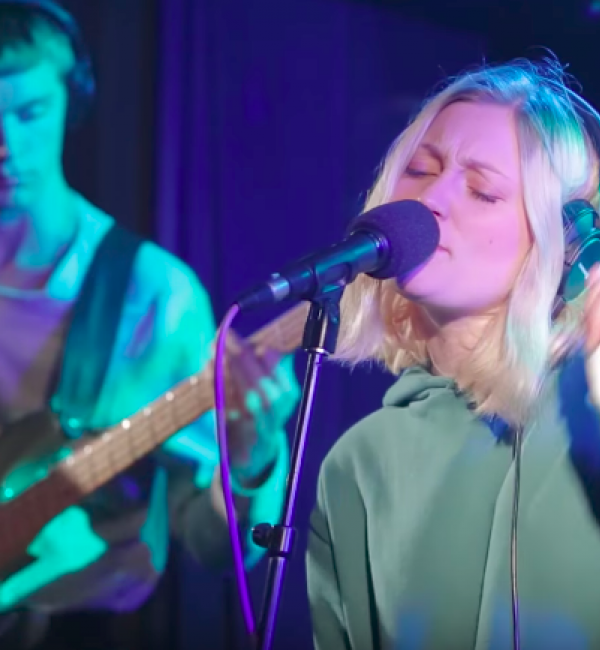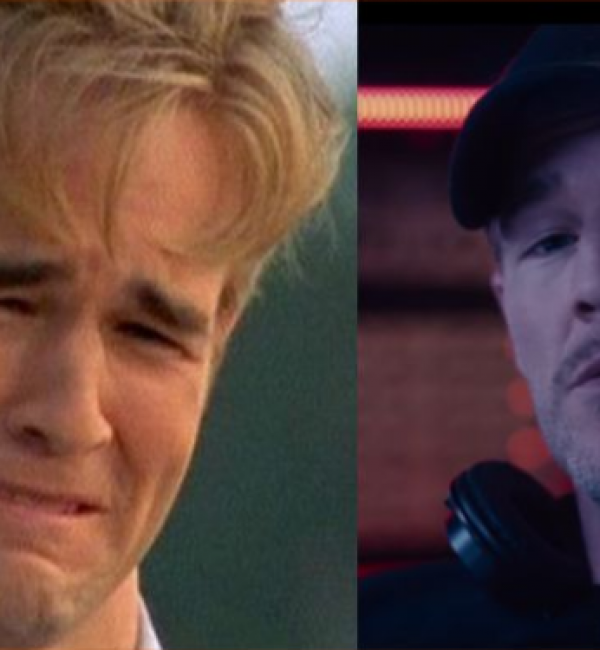The snarling tail of Dead Projectionists clasps us then releases two songs later. We’re late. It’s already very much going on. Slightly slim on bodies perhaps, but whoever is here, is dredging up whatever party they have in them this Tuesday night. There’s a guy in here who looks like what I imagine Julian Casablancas would look like if he quit the Strokes after the first album and lived at his nearest bar and survived on a diet of cranberry and vodka for 35 years. He’s wearing braces over a leather jacket and Ray-Ban Wayfarers at 9:30pm inside a dark club and twirling his finger with an arm raised above his head while his hips jerk in what must seem to him to be gyration. He’s definitely older than my Dad by at least half a decade.
REPUTATION FERMENTING INTO ALLURE
Other than providing a useful segway for me, the other reason this guy is my fucking hero is that he makes me feel better about being old while being surrounded by young, beautiful Canadians. He’s a great visual reminder about the history of Toronto’s Silver Dollar Room as a venue (again, thanks for the segway). It’s frontage is still streaked with as much neon as a Vegas money pit, but it’s reputation is somewhat different now. As well as being home to poet Milton Acorn and other undernourished artists, it had a reputation in the 70s for violence and crime. A reputation that fermented into a kind of allure after Elmore Leonard featured it in the opening line of his 1989 crime novel Killshot. One side of the venue is a band room and bar and on the other side of the wall are rows of gleaming emerald diner booths and white formica tables with orbital lights, all completely empty. To call it Lynchian doesn’t quite cover how exquisitely strange it is.
EVERYTHING IS A DRUM
As the second band—Toronto’s Peers—begin their jutting, locomotive pop, people begin to move. It’s that kind of half dancing that looks like a room full of people shuffling heavy furniture around a tight corner. And it’s music that deserves movement. Everything in Peers, is a kind of drum. Guitars and keys stab in syncopation, vocals swing gymnastically around the rhythm. The overall affect is of a more-fun Franz Ferdinand or a slightly amphetamised Future Islands with many moments on a spectrum running all the way between Alt J and the B52s. They’re an undeniably good time.
The two older photographers from last night are dutifully taking pictures. One is a lady with what looks like a cassette tattooed on his upper arm. The other is a white haired (at least 65+) gentleman occupying the same plaid shirt and tan cap. I want to ask who he’s taking pictures for but I know it will decimate the fantasy I have of him relinquishing his responsibilities on a farmlet in rural Ontario to get amongst it in the dive bars of Toronto—I leave it be.
IN WHAT POST-NUCLEAR HYPOTHESIS CAN DANCEPUNK FAIL TO PERSIST?
The elderly, leather-embalmed and perpetually drunk version of Julian Casablancas is still twirling his finger over his head and continuing to subsist on our imagination that convinces us that once, perhaps very long ago, he was way cooler than us. The music that he has been twirling his finger to is LA’s Moving Units, dance-punk of mid-000s vintage that has somehow despite band member departures and the general passage of time, still exists today. During one song, where gang vocals chant “let’s not stay either way” I wonder what post-nuclear hypothesis dance-punk might fail to survive? I look dimly ahead, thinking about how great The Rapture were, once. There’s something desiccated about Blake Millar in 2016. He has that perfectly preserved look you get by leaving something on a car dashboard for three consecutive months of summer. And as soon as Peers’ portable neon ‘PEERS’ sign was extinguished, so was the presence of the girls at the front of stage, performing some downright heroic dancefloor CPR. A phalanx of very ardent dudes emerged in their absence, forming a small, burly phalanx in front of the band. In the end, Moving Units really delivered what they do–it is genuinely hard to keep still while listening to them, and more than a few of their songs are still painted on the inside of my skull. They managed to surmount my bad memories of the 000s for about half an hour. That in itself is some commendable heavy-lifting.
WELCOME TO THE FUTURE
Part of what NXNE 2016 is doing differently is FUTURE LAND—a one-day conference primarily about game design. The keynote is from Nolan Bushnell, the guy who founded Atari (and also Chuck E Cheese which, given Bushnell is an engineer, makes the restaurant chain’s fidelity to arcade games and animatronics so much more understandable.) There’s interactive games outside the main conference areas which allow delegates to run on a peddleboard to escape the onscreen zombies (designed by Toronto game design students) or lurch around in VR goggles like zombies themselves.
Being a human that like likes words (and even more when they’re arranged into stories etc) I chose to lurk inside the ‘Masterclass on Storytelling and Game Development’. The session’s panellists Navid Khavari and Kaitlyn Tremblay are similar in that they’re both passionately employed in the service of crafting and advocating narratives in videogames—though their respective roles are quite different. Khavari works for Ubisoft in Toronto and has done work for prestigious titles like Splinter Cell and Tremblay is in publishing as well as game design and has carved out a unique role in the gaming world not only as a reviewer but as a developer and writer of games that deal with feminism and mental health. I expected that despite the overarching theme being storytelling, that I’d have to peel myself off the seat around 1/3 of the way in because, honestly, as a realm of interest videogames only overlaps with my own interests in the faintest of ways. But I didn’t need to slink out at all.
“There’s a beauty to the proliferation of narrative in games” Tremblay attests. “It’s visceral, it’s non-stop” Khavari chimes in. They describe their way of writing as of-the-moment, and completely malleable. There needs to be several ways a certain situation may unfold, there has to be short lines, long arcs and it has to suit the gameplay. For a lot of writers, not to be able to create that meringue-like perfect story uncompromised by game mechanics and interactivity and endless possibility would be a nightmare. These guys love it, they thrive on it. “Being not married to what you’re doing is really important” Khavari confirms. It’s an area that maybe not a lot of people think about being perfect for. But there’s sound designers, writers, programmers, animators, illustrators, all in the same team. Khavari spilt coffee over some classified documents at a consulte interview and defaulted to working for a small games company. Tremblay never throught about writing for games until someone suggested it to her. And both found what they loved. And much against the idea of generecised stories for the sake of game mechanics or algorhythmically produced narratives that seems to be touted as growing concerns in games with better and better graphics and play, neither Khavari or Tremblay think stories in games are of diminishing importance—quite the opposite. Tremblay shrugs: “People still need catharsis”.
The night is consumed in more shows spilling through a handful more venues. The weathered psych-pop of Tuns and the stratospheric, oxygen-thin strains of Only Yours at the Garrison are total highlights. It’s sprawling, sense-drenching. It ends after the festival shows are over, with a Led Zeppelin cover band in a subterranean dive bar, fronted by a 70 year old man.
This has been just a taste of NXNE, and hopefully not too cruel in it’s its singular focus on the festival’s first three days. But I thought it was important to make clear—the core of this festival remains the discoveries you can make by just turning up and listening. Schoolboy Q, Father John Misty and the rest of the weekend luminaries at the Port Lands portion of the festival will always be great, but if you are in Toronto next year around this time, it’s on all week. I shudder to think how much I’d write if I did any more than this three-day primer.
There’s still mystery in NXNE, still chance. Things to make the most of—now more than ever.
-Paul Cumming for Cool Accidents




